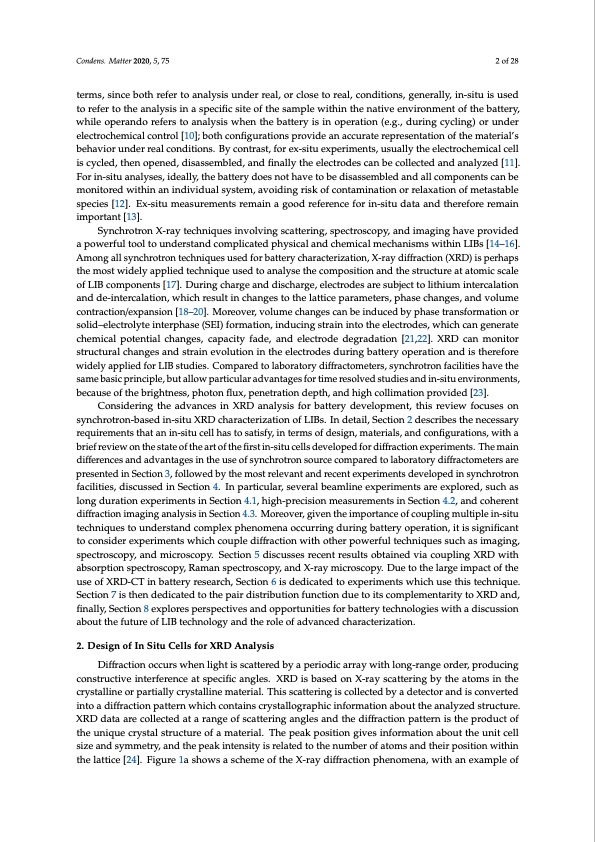
PDF Publication Title:
Text from PDF Page: 002
Condens. Matter 2020, 5, 75 2 of 28 terms, since both refer to analysis under real, or close to real, conditions, generally, in-situ is used to refer to the analysis in a specific site of the sample within the native environment of the battery, while operando refers to analysis when the battery is in operation (e.g., during cycling) or under electrochemical control [10]; both configurations provide an accurate representation of the material’s behavior under real conditions. By contrast, for ex-situ experiments, usually the electrochemical cell is cycled, then opened, disassembled, and finally the electrodes can be collected and analyzed [11]. For in-situ analyses, ideally, the battery does not have to be disassembled and all components can be monitored within an individual system, avoiding risk of contamination or relaxation of metastable species [12]. Ex-situ measurements remain a good reference for in-situ data and therefore remain important [13]. Synchrotron X-ray techniques involving scattering, spectroscopy, and imaging have provided a powerful tool to understand complicated physical and chemical mechanisms within LIBs [14–16]. Among all synchrotron techniques used for battery characterization, X-ray diffraction (XRD) is perhaps the most widely applied technique used to analyse the composition and the structure at atomic scale of LIB components [17]. During charge and discharge, electrodes are subject to lithium intercalation and de-intercalation, which result in changes to the lattice parameters, phase changes, and volume contraction/expansion [18–20]. Moreover, volume changes can be induced by phase transformation or solid–electrolyte interphase (SEI) formation, inducing strain into the electrodes, which can generate chemical potential changes, capacity fade, and electrode degradation [21,22]. XRD can monitor structural changes and strain evolution in the electrodes during battery operation and is therefore widely applied for LIB studies. Compared to laboratory diffractometers, synchrotron facilities have the same basic principle, but allow particular advantages for time resolved studies and in-situ environments, because of the brightness, photon flux, penetration depth, and high collimation provided [23]. Considering the advances in XRD analysis for battery development, this review focuses on synchrotron-based in-situ XRD characterization of LIBs. In detail, Section 2 describes the necessary requirements that an in-situ cell has to satisfy, in terms of design, materials, and configurations, with a brief review on the state of the art of the first in-situ cells developed for diffraction experiments. The main differences and advantages in the use of synchrotron source compared to laboratory diffractometers are presented in Section 3, followed by the most relevant and recent experiments developed in synchrotron facilities, discussed in Section 4. In particular, several beamline experiments are explored, such as long duration experiments in Section 4.1, high-precision measurements in Section 4.2, and coherent diffraction imaging analysis in Section 4.3. Moreover, given the importance of coupling multiple in-situ techniques to understand complex phenomena occurring during battery operation, it is significant to consider experiments which couple diffraction with other powerful techniques such as imaging, spectroscopy, and microscopy. Section 5 discusses recent results obtained via coupling XRD with absorption spectroscopy, Raman spectroscopy, and X-ray microscopy. Due to the large impact of the use of XRD-CT in battery research, Section 6 is dedicated to experiments which use this technique. Section 7 is then dedicated to the pair distribution function due to its complementarity to XRD and, finally, Section 8 explores perspectives and opportunities for battery technologies with a discussion about the future of LIB technology and the role of advanced characterization. 2. Design of In Situ Cells for XRD Analysis Diffraction occurs when light is scattered by a periodic array with long-range order, producing constructive interference at specific angles. XRD is based on X-ray scattering by the atoms in the crystalline or partially crystalline material. This scattering is collected by a detector and is converted into a diffraction pattern which contains crystallographic information about the analyzed structure. XRD data are collected at a range of scattering angles and the diffraction pattern is the product of the unique crystal structure of a material. The peak position gives information about the unit cell size and symmetry, and the peak intensity is related to the number of atoms and their position within the lattice [24]. Figure 1a shows a scheme of the X-ray diffraction phenomena, with an example ofPDF Image | Synchrotron-Based X-ray Diffraction for Lithium-Ion Batteries

PDF Search Title:
Synchrotron-Based X-ray Diffraction for Lithium-Ion BatteriesOriginal File Name Searched:
condensedmatter-05-00075.pdfDIY PDF Search: Google It | Yahoo | Bing
Sulfur Deposition on Carbon Nanofibers using Supercritical CO2 Sulfur Deposition on Carbon Nanofibers using Supercritical CO2. Gamma sulfur also known as mother of pearl sulfur and nacreous sulfur... More Info
CO2 Organic Rankine Cycle Experimenter Platform The supercritical CO2 phase change system is both a heat pump and organic rankine cycle which can be used for those purposes and as a supercritical extractor for advanced subcritical and supercritical extraction technology. Uses include producing nanoparticles, precious metal CO2 extraction, lithium battery recycling, and other applications... More Info
| CONTACT TEL: 608-238-6001 Email: greg@infinityturbine.com | RSS | AMP |